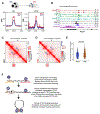G-quadruplexes associated with R-loops promote CTCF binding
- PMID: 37552993
- PMCID: PMC10529333
- DOI: 10.1016/j.molcel.2023.07.009
G-quadruplexes associated with R-loops promote CTCF binding
Abstract
CTCF is a critical regulator of genome architecture and gene expression that binds thousands of sites on chromatin. CTCF genomic localization is controlled by the recognition of a DNA sequence motif and regulated by DNA modifications. However, CTCF does not bind to all its potential sites in all cell types, raising the question of whether the underlying chromatin structure can regulate CTCF occupancy. Here, we report that R-loops facilitate CTCF binding through the formation of associated G-quadruplex (G4) structures. R-loops and G4s co-localize with CTCF at many genomic regions in mouse embryonic stem cells and promote CTCF binding to its cognate DNA motif in vitro. R-loop attenuation reduces CTCF binding in vivo. Deletion of a specific G4-forming motif in a gene reduces CTCF binding and alters gene expression. Conversely, chemical stabilization of G4s results in CTCF gains and accompanying alterations in chromatin organization, suggesting a pivotal role for G4 structures in reinforcing long-range genome interactions through CTCF.
Keywords: CTCF; G-quadruplex; R-loops; genome organization.
Copyright © 2023 Elsevier Inc. All rights reserved.
Conflict of interest statement
Declaration of interests The authors declare no competing interests.
Figures






References
Publication types
MeSH terms
Substances
Grants and funding
LinkOut - more resources
Full Text Sources
Molecular Biology Databases

